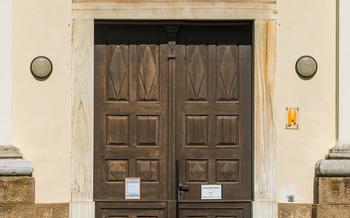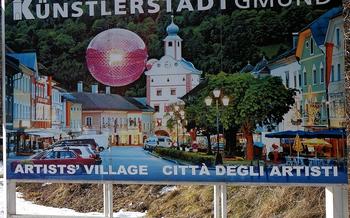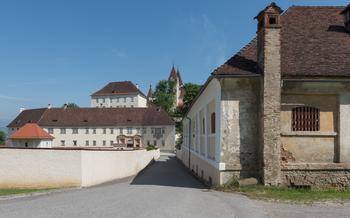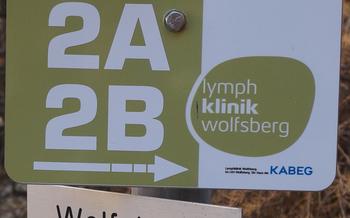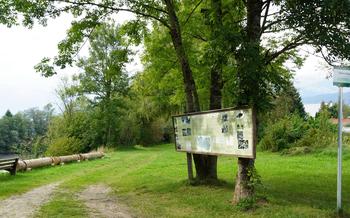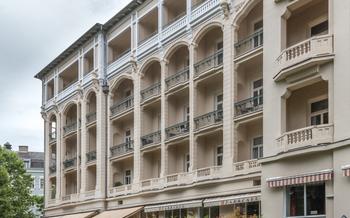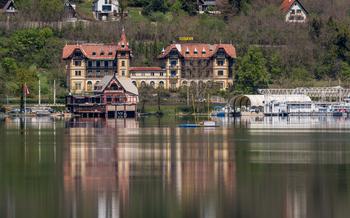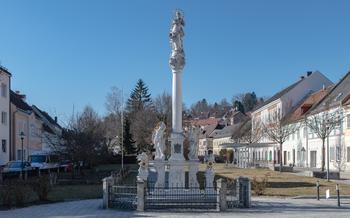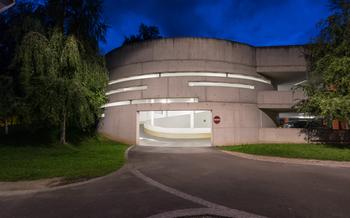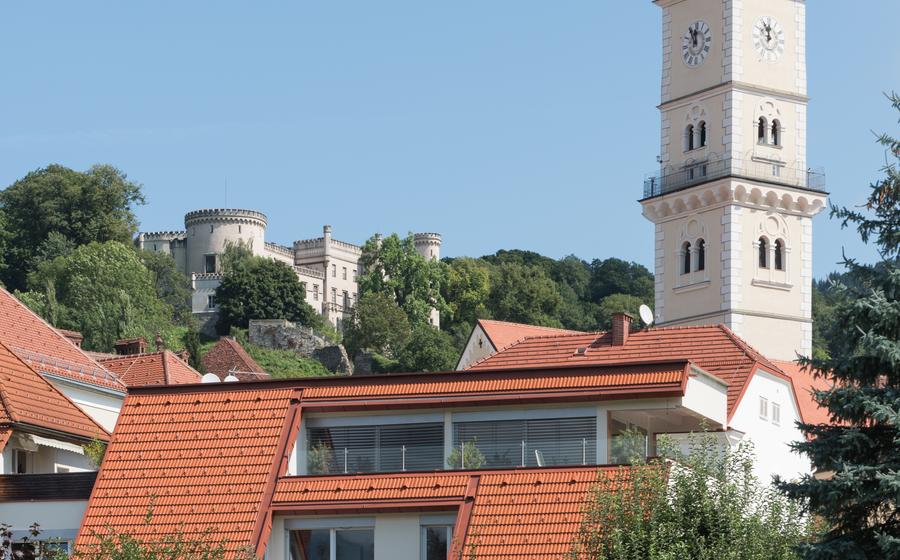
Viktring Abbey
- Historical Significance
- Architectural Marvel
- Monastic Life
- Library and Scriptorium
- Art and Craft
- Economic Contributions
- Social Welfare
- Secularization and Dissolution
- Restoration and Revival
- Viktring Abbey Museum
- Guided Tours
- Pilgrimage Route
- Insider Tip: Viktring Abbey Festival
Historical Significance
Nestled amidst the picturesque landscapes of Carinthia, Austria, stands Viktring Abbey, a testament to the region's rich history and spiritual heritage. Founded in 1142 by Duke Heinrich of Carinthia, the abbey played a pivotal role in shaping the religious, cultural, and economic landscape of medieval Carinthia. Affiliated with the Cistercian order, the abbey embraced the strict Benedictine rule, emphasizing a life of prayer, work, and self-sufficiency. As a center of spirituality and learning, Viktring Abbey attracted scholars, artists, and pilgrims from across the region, contributing significantly to the intellectual and cultural development of Carinthia.
Architectural Marvel
Viktring Abbey stands as a testament to the architectural ingenuity of the Cistercian order. Constructed in the Romanesque-Gothic style, the abbey seamlessly blends simplicity and grandeur, exuding an aura of both austerity and elegance. Its three naves, separated by slender columns and topped by ribbed vaults, create a sense of spaciousness and luminosity. The impressive westwork, with its two towers flanking a rose window, adds a touch of majesty to the abbey's facade.
Intricate carvings, sculptures, and stained glass windows adorn the abbey's interior, adding to its visual splendor. The capitals of the columns feature intricate carvings depicting biblical scenes, mythical creatures, and floral motifs. The choir stalls, meticulously crafted from wood, showcase the exceptional artistry of the Cistercian monks. The stained glass windows, with their vibrant hues and intricate designs, cast a kaleidoscope of colors onto the abbey's interior, creating an ethereal atmosphere that invites contemplation and reverence.
Monastic Life
The Cistercian monks who inhabited Viktring Abbey lived a life of prayer, work, and study, guided by the strict Benedictine rule. They rose before dawn for the first of their eight daily prayer services, which were held in the abbey's magnificent church. The remainder of the day was divided between manual labor and intellectual pursuits. The monks tended to the abbey's extensive lands, working in the fields, vineyards, and workshops. They also maintained the abbey's impressive library, where they copied and illuminated manuscripts. The abbey's scriptorium was renowned for its production of beautifully illustrated manuscripts, which were highly sought after by collectors throughout Europe.
Library and Scriptorium
The Viktring Abbey library was renowned throughout medieval Carinthia for its extensive collection of manuscripts. This collection, which included over 500 volumes, was meticulously organized and cataloged by the abbey's monks. The manuscripts covered a wide range of subjects, including theology, philosophy, history, and science. Many of these manuscripts were beautifully illuminated, featuring intricate drawings and calligraphy.
In addition to its collection of manuscripts, the abbey also maintained a scriptorium, where monks meticulously copied and illuminated manuscripts. The scriptorium was an important center of learning and scholarship, and the monks who worked there were highly skilled in the art of manuscript production. The manuscripts produced in the scriptorium were not only used by the monks themselves but were also sold to other monasteries and libraries throughout the region.
The Viktring Abbey library and scriptorium played a vital role in the preservation and transmission of knowledge during the Middle Ages. The collection of manuscripts that was amassed by the monks was a valuable resource for scholars and students alike. The scriptorium produced manuscripts that were not only beautiful but also accurate and reliable, helping to ensure that knowledge was passed down from one generation to the next.
Art and Craft
Viktring Abbey was not only a center of spirituality but also a hub of artistic creativity. The monks were skilled craftsmen and produced a wide range of art and craft objects, including metalwork, goldsmithing, and embroidery. They created intricate chalices, monstrances, and reliquaries, using precious metals and gemstones. The abbey's goldsmiths were particularly renowned for their skill in creating elaborate and opulent liturgical objects.
The monks also excelled in embroidery, producing exquisite vestments and altar cloths. Their embroidery often featured intricate designs and vivid colors, depicting religious scenes and symbols.
In addition to creating objects for liturgical use, the monks also produced a variety of other items, such as furniture, clothing, and tools. They were skilled carpenters and weavers, and their products were highly sought after by the surrounding community.
The abbey's commitment to art and craft not only enriched the abbey's own liturgical life but also contributed to the cultural heritage of the region. The abbey's workshops were a training ground for local artisans and craftsmen, and the abbey's products were widely distributed and admired.
Economic Contributions
Viktring Abbey played a significant role in the local economy. The monks engaged in various economic activities to support themselves and contribute to the prosperity of the region. They were skilled in agriculture, viticulture, and land reclamation. The abbey's vast estates provided them with the resources they needed to sustain their community. The monks cultivated crops, raised livestock, and produced wine. They also engaged in trade and commerce, selling their surplus products and acquiring goods they needed from other regions. The abbey's economic activities stimulated the local economy and provided employment opportunities for the surrounding population. The monks' expertise in agriculture and viticulture helped to improve farming practices and increase agricultural productivity in the region. The abbey's involvement in trade and commerce facilitated the exchange of goods and ideas, contributing to the economic and cultural development of Carinthia.
Social Welfare
Viktring Abbey was deeply committed to social welfare and played a crucial role in providing assistance to the poor and needy within the community. The abbey established a hospital within its premises, which provided medical care and refuge to the sick and injured. The hospital was staffed by monks trained in medicine and herbal remedies, offering compassionate care to those in need.
Beyond the hospital, the abbey engaged in various charitable activities to support the vulnerable. It provided food, shelter, and assistance to travelers and pilgrims who sought refuge within its walls. The monks distributed alms to the poor and needy, offering them sustenance and relief during difficult times.
Through these initiatives, Viktring Abbey demonstrated its commitment to social justice and compassion. The abbey's charitable endeavors not only alleviated suffering but also fostered a sense of community and support among the people of the region.
Secularization and Dissolution
During the 15th and 16th centuries, Viktring Abbey faced a gradual decline due to political and economic factors. The Protestant Reformation and the rise of secularism led to a decrease in the number of monks and a decline in the abbey's income. The abbey also suffered from the effects of the Turkish invasions, which ravaged Carinthia and disrupted the region's economy.
In 1782, Viktring Abbey was secularized by Emperor Joseph II as part of his efforts to dissolve monasteries and confiscate their wealth. The abbey's buildings were sold, and its library and archives were dispersed. The abbey church was converted into a parish church, while the remaining buildings were used for various purposes, including a school and a hospital.
The dissolution of Viktring Abbey marked the end of an era, but its legacy continued to live on. The abbey's buildings and its rich history remained a source of inspiration and pride for the people of Carinthia. In the centuries that followed, efforts were made to restore and revive the abbey, leading to the establishment of the Viktring Abbey Museum and the renewed interest in the abbey's cultural significance.
Restoration and Revival
After centuries of neglect and decay, the 19th and 20th centuries witnessed a renewed interest in Viktring Abbey and its rich heritage. In the 1850s, the Benedictine monks of St. Paul's Abbey in Lavanttal initiated a campaign to restore the abbey church. Led by the architect and monk, Virgil Rainer, the restoration involved rebuilding the collapsed nave, reconstructing the westwork, and restoring the original Gothic features of the church.
In the early 20th century, further restoration efforts were undertaken by the Carinthian Heritage Society. The society focused on preserving the abbey's remaining buildings, including the chapter house, the refectory, and the infirmary. These efforts culminated in the establishment of the Viktring Abbey Museum in 1935, which aimed to showcase the abbey's history, art, and cultural significance.
Today, Viktring Abbey stands as a testament to the enduring legacy of the Cistercian order and its centuries-long influence on the spiritual, cultural, and economic development of Carinthia. Its restored buildings, museum, and guided tours offer visitors a unique glimpse into the rich history and heritage of this once-great abbey.
Viktring Abbey Museum
Housed within the former abbey's buildings, the Viktring Abbey Museum is a treasure trove of artifacts and exhibits that illuminate the abbey's rich history and cultural significance. Here, visitors can delve into the lives of the Cistercian monks who once inhabited these hallowed halls and explore the diverse artistic and religious treasures they left behind.
The museum's collection encompasses a vast array of manuscripts, sculptures, liturgical objects, and other artifacts that provide a glimpse into the abbey's spiritual, artistic, and economic endeavors. From intricately illuminated manuscripts to exquisitely crafted metalwork and goldsmithing, each piece tells a story of the abbey's contributions to medieval culture and craftsmanship.
Interactive exhibits and multimedia displays bring the abbey's history to life, allowing visitors to experience the daily routines, rituals, and challenges faced by the Cistercian monks. Through these immersive displays, visitors gain a deeper understanding of the abbey's role as a center of learning, spirituality, and economic activity.
The museum also highlights the abbey's connections to the surrounding community and its significance as a pilgrimage site. Visitors can learn about the abbey's charitable activities, its role in providing spiritual guidance and support, and its enduring legacy as a place of reverence and contemplation.
A visit to the Viktring Abbey Museum is an essential experience for anyone interested in medieval history, art, and culture. Here, visitors can immerse themselves in the rich heritage of this remarkable abbey and gain a profound appreciation for its enduring contributions to the region and beyond.
Guided Tours
Visitors to Viktring Abbey can embark on guided tours that provide an in-depth exploration of its history, architecture, and significance. These tours are led by knowledgeable guides who share insights into the abbey's foundation, monastic life, and contributions to the region.
During the tours, visitors can marvel at the abbey's impressive Romanesque-Gothic architecture, including its three naves, ribbed vaults, and intricate carvings. They can learn about the daily lives of the Cistercian monks, their routine of prayer, work, and study, and their commitment to self-sufficiency.
The guides also shed light on the abbey's role as a spiritual center, providing religious services to the surrounding community and serving as a pilgrimage site. Visitors can discover the abbey's association with notable saints, such as Hemma of Gurk, and its significance as a stop on the Carinthian Pilgrimage Route.
To ensure a memorable experience, it is advisable to book guided tours in advance, especially during the peak tourist season. These tours offer a comprehensive understanding of Viktring Abbey's rich history and cultural heritage, allowing visitors to connect with the past and appreciate the enduring legacy of this remarkable institution.
Pilgrimage Route
Viktring Abbey holds a significant place along the Carinthian Pilgrimage Route, a renowned spiritual trail that traverses several sacred sites in the region. This route offers pilgrims an opportunity to embark on a journey of faith and self-discovery, connecting with the rich religious heritage of Carinthia.
As pilgrims make their way along the path, they encounter various monasteries, churches, and pilgrimage chapels, each possessing its own unique history and spiritual significance. Viktring Abbey stands as a prominent stop on this route, inviting pilgrims to delve into its storied past and embrace its sacred atmosphere.
The abbey's role as a spiritual center and place of worship has drawn pilgrims for centuries. Its association with notable saints, such as Hemma of Gurk, and its reputation as a pilgrimage site further enhance its significance.
Whether seeking spiritual guidance, solace, or a deeper connection with their faith, pilgrims find Viktring Abbey to be a welcoming and inspiring destination along the Carinthian Pilgrimage Route. The abbey's serene surroundings, coupled with its rich history and spiritual energy, create an ideal setting for contemplation and reflection.
Insider Tip: Viktring Abbey Festival
For an unforgettable experience, plan your visit to Viktring Abbey during the annual Viktring Abbey Festival, usually held in the summer months. Immerse yourself in the abbey's rich heritage and vibrant atmosphere as the festival brings the abbey's history to life through a variety of events and activities.
Attend captivating concerts featuring classical music, choral performances, and traditional Austrian folk music within the abbey's hallowed walls. Explore fascinating exhibitions that delve into the abbey's art, architecture, and spiritual significance. Join guided tours led by knowledgeable experts who share captivating stories and insights, bringing the abbey's past to life.
The festival offers a unique opportunity to connect with the abbey's spiritual essence and experience its enduring legacy. Whether you're a history buff, an art enthusiast, or simply seeking a profound cultural experience, the Viktring Abbey Festival promises an unforgettable journey into the heart of this remarkable place.
